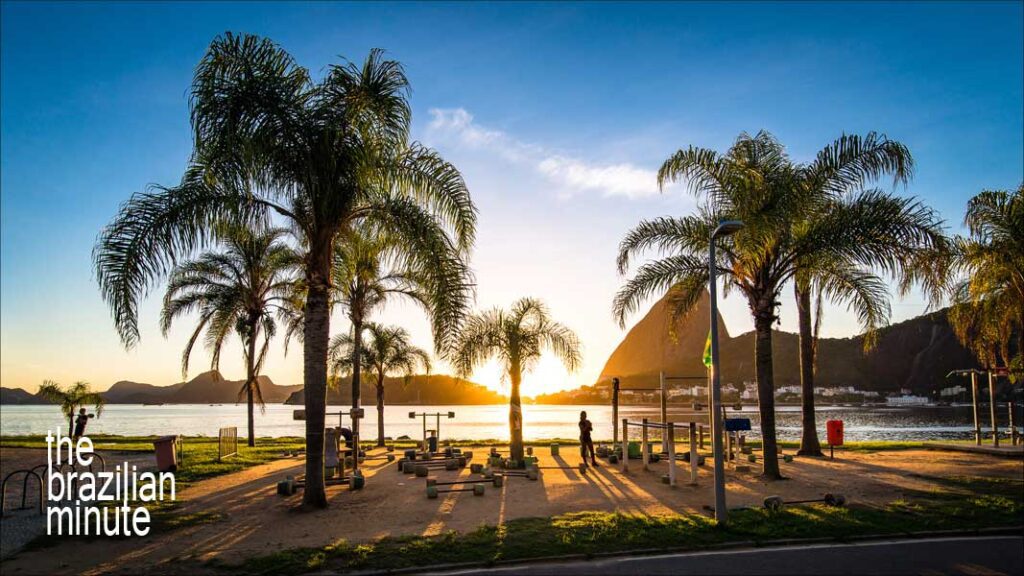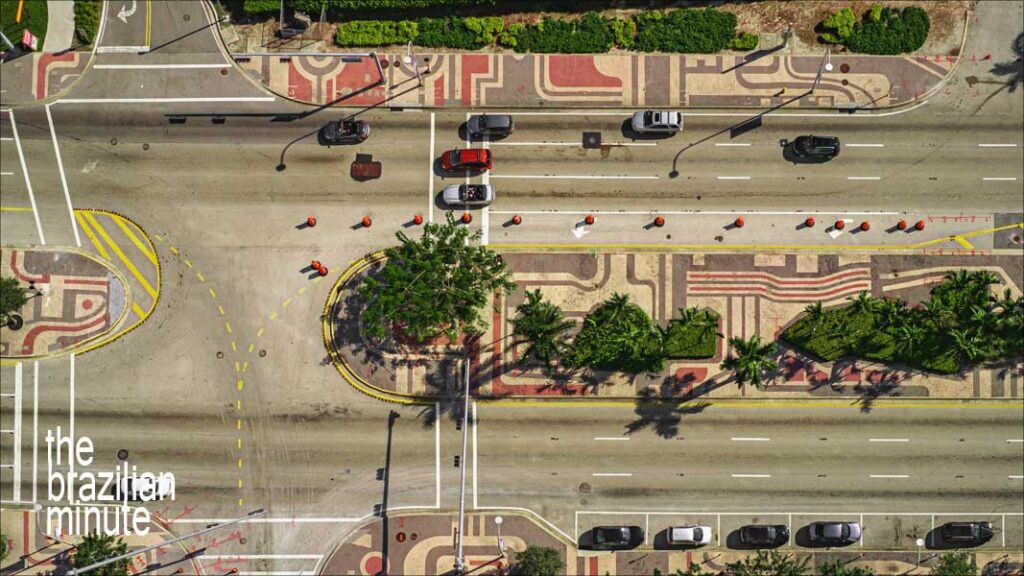
The Brazilian Artist Who Painted With Plants.
Roberto Burle Marx’s landscape masterpieces are redefining the urban scene while creating tranquility in personal spaces.
This series was presented by the Consulate-General of Brazil in Chicago and the Brazilian Foreign Ministry’s Cultural Department.
In celebration of Brazil’s Bicentennial year, 1822 – 2022
This week’s Brazilian Minute: Roberto Burle Marx’s Landscape Masterpieces
Catch up with other Brazilian Minute episodes you may have missed!
Script from Audio:
Anyone who’s ever been to Rio de Janeiro will tell you that some of the most unforgettable sights of the city are to be found not by looking up, but by looking down.
The swirling mosaic sidewalks that line Rio’s beaches come from Brazilian artist Roberto Burle Marx. His balance of nature and metropolis elevates landscape design to an art form.
Burle Marx studied painting, architecture, and botany to amplify the distinctive harmony of his projects. He paints with plants.
He created the UNESCO headquarters gardens in Paris and the cascading fountains at Brasilia’s Ministry of Justice.
So, next time you travel, look around. You might come across one of more than 1,500 parks and gardens worldwide that are the legacy of Brazilian artist Roberto Burle Marx.
Read and listen to new weekly episodes of The Brazilian Minute. It’s brought to you by the Consulate General of Brazil, in Chicago and the Brazilian Foreign Ministry’s Cultural Department.
More on: Roberto Burle Marx’s Landscape Masterpieces
Overview:
Roberto Burle Marx is a Brazilian original. A man of exceptional talent for art, design, and urban planning. His life’s work in these fields has created a lasting legacy for the world to enjoy.
His expertise with plant types, textures, and contract reflect a nativist perspective. This practicality carried over to his interest in Botany, having discovered roughly 50 plant species during his career.
Notably, Roberto Burle Marx was one of the first to publicly raise the issue of Amazon deforestation.
Burle Marx was born in Sao Paulo on August 4th, 1909. Surprisingly, he was introduced to the tropical flora of his homeland while living abroad in Germany while still a teen. Time spent in Berlin’s Dahlem Botanic Garden made an enduring impression.
He returned home to develop his skills in painting, architecture, and landscape design under the guidance of Brazilian architect Lucio Costa. Ultimately, Burle Marx assumed his first major post with the northeastern state of Pernambuco, as Director of public parks.
Without a doubt, the iconic, mosaic-tiled sidewalks that line Copacabana beach in Rio de Janeiro are his best-known work, worldwide. That’s just one of Roberto Burle Marx’s landscape masterpieces
During his lifetime, Roberto Burle Marx created more than 3,000 parks, promenades, and gardens, worldwide.
His creations can be seen throughout Brazil, South America, and Europe, as well as Miami Beach, Los Angeles, and Washington D.C.
In fact, you may have experienced Bule Marx in real life if you’ve walked along Miami’s Biscayne Boulevard. This is probably his most famous landscape project in the USA. It took more than 16 years to complete.
Landscape Masterpieces Revealed In Print
Burle Marx’s life and artistry have been captured and portrayed in a new book, Sítio Roberto Burle Marx, named after his Rio de Janeiro home.
The book’s perspective is as personal as his art. The book takes you through his home, one room at a time, to experience, explore and discover Burle Marx’s varied interests, collections, and hobbies. Much of his art collection is featured, as are many of Roberto Burle Marx’s landscape masterpieces.
At the moment the property Sítio Roberto Burle Marx is on the list of cultural heritage organizations of the state of Rio de Janeiro (1988), the Union (2000), and a candidate for Historic Heritage of Humanity by the United Nations Educational Organization, Science and Culture (UNESCO).
The 309-page hardcover book is presented in association with Intermuseus and the National Institute of Historic and Artistic Heritage (IPHAN). It was authored by Andrey Rosenthal Schlee, Claudia Maria P. Storino, José Tabacow, Vera Beatriz Siqueira, and Yanara Costa Haas. The English translation was done by Philip Somervell.
Sítio Roberto Burle Marx is available in a free digital version and in a printed version by request. Please refer to The Brazilian Minute when contacting by email: [email protected].
Let’s take a leisurely stroll through a trio of his very best. Enjoy!
Roberto Burle Marx’s Landscape Masterpieces
Copacabana, Rio de Janeiro

Can you imagine Rio de Janeiro without Roberto Burle Marx’s signature sidewalk designs for Copacabana? And it’s not just the sidewalks. Virtually every space along Avenida Atlantica’s curving 2.5-mile stretch carries Burle Marx’s angular touch.
Looking for a pattern? Apart from the wave design (known as Calçada Portuguesa), no two areas are alike. The result is a visual and vibrant sense of energy and motion. Burle Mark’s design reflects Rio de Janeiro’s special relationship with nature.
Flamengo Park, Rio de Janeiro

This Brazilian gem is one of the city’s most scenic parks, and also the world’s largest urban park, and a UNESCO site.
Flamengo Park is situated on Guanabara Bay, directly across from Sugarloaf Mountain. It is midway between Santos Dumont Airport and Botafogo Beach.
The Park’s design incorporates the curving flow of Avenida Infante Dom Henrique as you enter Zona Sul from Rio de Janeiro’s city center. Parkland extends to both sides of the Avenue, creating a vast green space to welcome visitors to Rio’s beach districts.
Completed in 1965, Burle Marx’s design builds on nature’s environmental theme. Graceful, paved curves contrast texture and design for walking and cycling abound throughout its 120 hectares of greenery.
Flamengo Park is also known as Aterro do Brigadeiro Eduardo Gomes, is a living park, with various species of native plants and trees to accent the area. The park encourages outdoor activities of all kinds, including the 2007 PanAm games.
Within its confines are Rio de Janeiro’s Museum of Modern Art, The Carmen Miranda Museum, and the Glória Marina. A Marionette Theater, food stands, and restaurants are nearby.
Biscayne Boulevard, Miami

When Roberto Burle Marx made his proposal to the City of Miami in 1988, Biscayne Boulevard’s heyday was a fading memory. Known as “The Gateway to Miami”, the boulevard was one of the most heralded streets in the USA. Its popularity peaked in the 60s when it became a celebrity hotspot for Frank Sinatra and Hollywood’s biggest names.
Burle Marx offered a new approach. He contrasted the aquamarine hues of Biscayne Bay with earth tones meant to stimulate the local, urban environment.
The project was completed after his death and is now being revived. City leaders have promised to preserve the spirit of Burle Marx’s original theme in any redesign. One such proposal is called Biscayne Green. View it here.
Music, Travel, Friends, and Fun! 2022 marks Connect Brazil’s 25th year.
Roberto Burle Marx’s Landscape Masterpieces
Did you enjoy ’Roberto Burle Marx’s Landscape Masterpieces’? If you did, why not join us at Connect Brazil?
Sign up for our emails on Brazilian music, travel, friends, and fun. Listen to our ‘always live’ streaming station and streaming music channels, always free. Visit us on Facebook, and Twitter, and browse our Lifestyle Directory for Brazilian events coast to coast.










